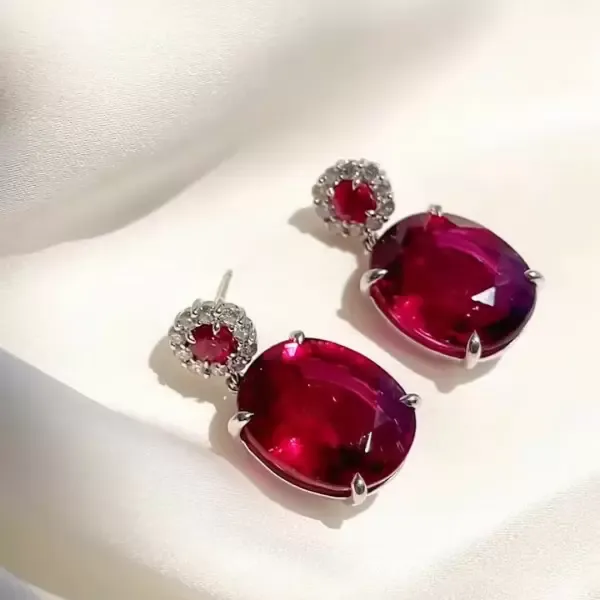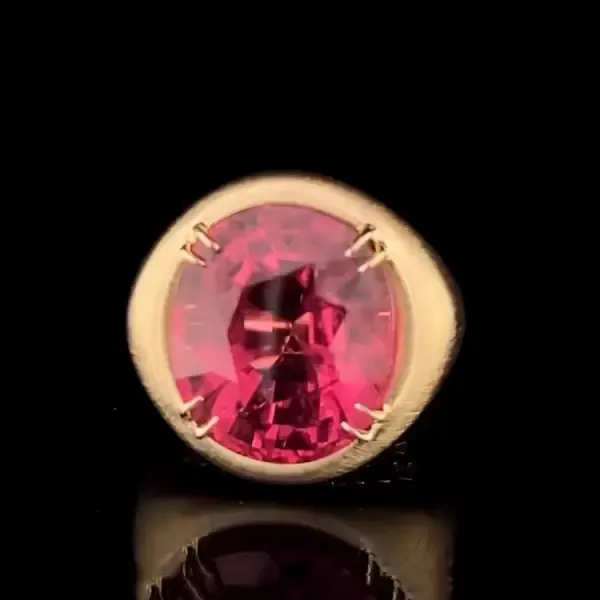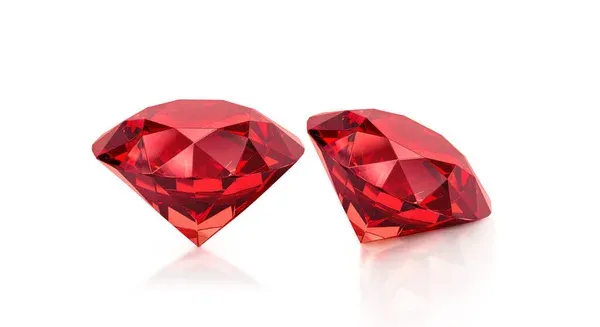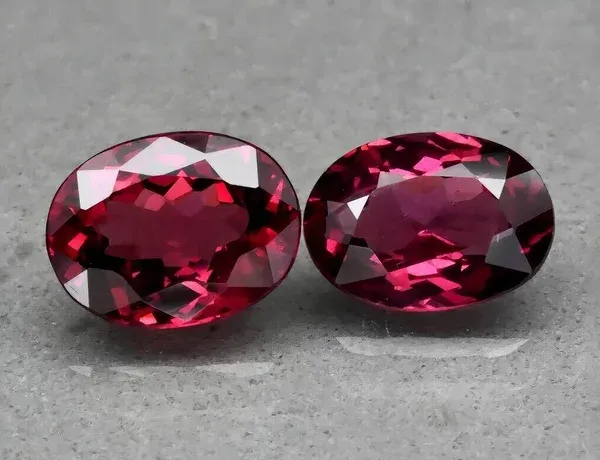Are you looking to purchase a ruby but unsure about How to tell if a ruby is real? This article is just what you need. Stay tuned to discover all the tips that How to identify real rubies. Let’s start by delving into the characteristics of authentic rubies.
Original rubies are famous for their deep red color due to the presence of chromium in the corundum mineral. Their rarity and exceptional hardness (second only to diamonds) make them highly valuable. The most coveted rubies come from Burma (Myanmar), known for their superior color and quality.
Rubies have been symbols of passion, protection, and prosperity throughout history. Across various cultures, rubies have been deeply associated with love and commitment, making them an ideal choice for a wedding ring.
When purchasing ruby gemstones, it’s important to be mindful of synthetic rubies. To ensure that you’re getting a genuine ruby stone, consider these tips:
Buy from reputable vendors that provide certifications and guarantees of authenticity such as sayabling.com.
Examine the ruby for imperfections such as bubbles, uneven color, or unnatural fluorescence.
What Makes a Ruby Real?

To discover How does a real ruby look like, it’s essential to understand the Four C’s of rubies:
- Color: Rich, vibrant red tones are highly sought after, with variations such as “pigeon’s blood” commanding top prices.
- Clarity: Rubies inclusions are considered more valuable, although certain imperfections like rutile silk can enhance their beauty.
- Cut: Well-proportioned cuts maximize the ruby’s brilliance and color intensity, enhancing its overall attractiveness.
- Carat Weight: Larger rubies are rarer and demand higher prices per carat compared to smaller stones.
Real Ruby vs. Fake Ruby: How to Differentiate
Many lab-created rubies are available now. So, How can jewelers authenticate ruby gemstones? Natural rubies, as the name suggests, are genuine stones that have not been modified by humans. Here are some tips for How to differentiate the real ruby vs fake ruby
Observe the color
When assessing a natural ruby, it’s important to look for a rich, vibrant red color, often described as “pigeon’s blood” red. The color should be uniformly distributed, without any irregular patches of color. While natural rubies are predominantly red, they can have subtle hints of other hues such as pink, purple, or orange.
It’s advisable to be cautious of rubies with an excessively bright or fluorescent appearance, as this could indicate artificial coloring or synthetic ruby. High-quality natural rubies display a deep, intense red color without any brown or gray undertones.
Lastly, observe how the ruby responds to light. Genuine rubies should maintain their beauty and color under different lighting conditions, including sunlight and artificial light sources.
Observe the Inclusion
Genuine rubies generally have small imperfections, such as tiny crystals, silk, rutile needles, or color zoning. Synthetic rubies often have gas bubbles or flux imperfections, which are not commonly found in natural rubies.
Observe under UV light
Rubies, both natural and synthetic, can exhibit fluorescence when exposed to ultraviolet (UV) light. The degree of fluorescence can vary depending on the ruby’s origin and specific trace elements present. For instance, Burmese rubies are known for strong fluorescence.
Synthetic rubies tend to fluoresce more than natural ones, and their fluorescent response may differ based on their creation method and additives. However, the UV light test alone is not definitive, as some natural rubies may not fluoresce, and some synthetic ones may mimic natural fluorescence. Additionally, treatments like heat treatment can affect a ruby’s fluorescent properties.
Observe the bubbles
During the synthetic manufacturing process of creating stones like rubies, bubbles can form as a result of methods like the Verneuil (flame-fusion) process. These bubbles appear as small, round, often spherical inclusions in the stone, and unlike natural inclusions found in real rubies, they have a uniform, bubble-like appearance.
Ask for a certificate
Remember to always obtain a certificate from a reputable gemological laboratory when buying a high-quality ruby. This certificate attests to the ruby’s authenticity, quality, and characteristics. The value of rubies makes obtaining a certificate essential, and the cost should not deter legitimate sellers.
If a high-quality ruby lacks certification, it should raise a red flag, indicating potential issues with its origin or quality. When dealing with expensive gemstones like rubies, insist on a certificate to ensure a secure and well-informed purchase.
How to Test a Ruby at Home: Simple Techniques

Rubies are considered one of the most valuable colored gemstones based on their price per carat. However, the market is flooded with fake rubies, making it challenging to differentiate between real and fake rubies. So, the question arises: How can one identify a real ruby? The most dependable way to confirm a ruby’s authenticity is by having it assessed by a certified jeweler.
- You can test the ruby at home, to gauge the ruby’s authenticity by examining its color and hardness. If possible, use a 10-power magnifier to carefully scrutinize the ruby.
- Ruby is highly durable and stable, scoring a 9 on the Mohs scale for hardness. This characteristic makes these astrological gemstones extremely popular, especially for customizing engagement rings.
- The purity of the color is crucial for both rubies and blue sapphires, as they are primary colors. While the secondary tones in a Thai ruby can help determine its origin and may be appealing, in general, the purer the red, the more valuable the ruby.
- Rubies are extremely tough, so they shouldn’t scratch easily. Use a damp cloth or a toothbrush to clean the ruby and remove any marks. Then, try scratching the gemstone with your fingernail. If it doesn’t scratch, it’s likely a genuine ruby. You can also test the ruby by scratching it with tools like a knife, sandpaper, or a piece of glass. If there’s no visible impact after this, the gem is probably real.
- Another test is to drag the ruby across a porcelain plate. If any colored streaks are left behind, the ruby is likely not genuine. Keep in mind that the absence of a streak doesn’t prove its authenticity, but the presence of a color streak suggests it’s not real.
- Genuine ruby gemstones originated naturally in caves and beneath the ground as minerals. As a result, minor flaws – a black spot, a line, or an inclusion – are expected inside the stone. To properly examine these, you will need a 10-power magnification since the small imperfections are difficult to see with the naked eye.
- Synthetic rubies are often flawless because replicating the slight imperfections found in real rubies is quite challenging. However, it’s important to note that any imperfection within the stone, except for bubbles, can be considered acceptable.
- Many attempts have been made to imitate gemstones using glass materials. When glass cools, bubbles tend to form, making them a good indicator. Synthetic rubies are created using glass. The color and hue of a ruby can never match that of glass. Therefore, a simple way to determine the authenticity of a ruby is to compare it with a piece of glass of a similar color. Compare a piece of genuine red glass with a fake stone. If they look the same, then the ruby stone is a fake.
- Careful examination of a ruby is one of the easiest methods to verify its authenticity. Rubies have a deep crimson color, often described as “vibrant” or “glowing” by many. Imitation rubies, like garnet or tourmaline, may have a similar color but often appear dull compared to a natural ruby.
Advanced Methods to Test Ruby Authenticity

Here are some gemstone testing methods used by gemologists to test the authenticity of a ruby:
- Microscopic Examination: Gemologists use a microscope to check for characteristic inclusions in natural rubies, such as silk and crystal inclusions, which may differ in synthetic rubies.
- Refractive Index Testing: Gemologists measure the refractive index of the ruby using a refractometer, with natural rubies typically having a refractive index of about 1.76-1.77.
- Spectroscopy: This technique analyzes the light spectrum emitted or absorbed by the ruby. Natural rubies have specific absorption lines, particularly in the red region, which can help differentiate them from synthetics or imitations.
- UV Light Examination: Natural rubies often exhibit a strong fluorescence under UV light, typically in a red to pink hue, while synthetics may have different fluorescence characteristics.
- Differential Thermal Analysis (DTA): This method measures how a ruby responds to temperature changes, with natural rubies having distinct thermal properties that differ from synthetic stones.
- Specific Gravity Measurement: Weighing the ruby in air and then in water can help determine its specific gravity, which can indicate whether it’s natural or synthetic.
Gem Testing Equipment: Advanced equipment like gem testers and electronic testing machines can provide detailed information about a stone’s properties, aiding in authenticity verification. - Laser Inscription: Some reputable dealers may inscribe a certificate number on the ruby stone, which can be verified with the issuing gemological lab.
FAQs: Ruby Identification
How can I tell if a ruby is real at home?
To determine if a ruby is real, you can try to scratch it with your fingernail. If it doesn’t get scratched, it’s probably authentic. You can also use tools like a knife, sandpaper, or a piece of glass to test the ruby by scratching it. Another method is to drag the ruby across a porcelain plate to look for colored streaks, which may indicate that the ruby is not genuine.
Do fake rubies glow under a black light?
When exposed to ultraviolet (UV) light, natural rubies typically emit a strong red or pink glow due to the presence of chromium. Synthetic rubies may also fluoresce, but they can exhibit varying colors or intensities of fluorescence. On the other hand, glass imitations might not fluoresce at all or could emit a different color, such as blue or green. While some fake rubies may glow under a blacklight, the specific color and intensity of the fluorescence can help distinguish them from genuine rubies.
How can I identify a natural ruby gemstone?
Look for a vibrant red color with good saturation and check for imperfections using a jeweler’s loupe or microscope. Natural rubies often contain inclusions such as silk, while synthetic ones tend to have fewer. Also, rubies are very hard, scoring 9 on the Mohs scale, so they should not scratch easily.
How much are real rubies worth?
The value of real rubies is determined by factors such as color, clarity, carat weight, cut, origin, and treatments. Prices can range from $200 to $1,000 or more for small rubies, $1,000 to $10,000 or more for mid-range rubies, and tens of thousands to hundreds of thousands of dollars for larger rubies. The market for rubies can fluctuate based on demand and availability, so it’s advisable to consult with a gemologist or reputable dealer for an accurate appraisal before buying or selling.
Conclusion
To tell if a ruby is real, you can use a combination of visual inspection, physical tests, and advanced gemological methods. Natural rubies are known for their deep red color, minor imperfections, and exceptional hardness.
To tell the difference between real and synthetic rubies, it’s important to look at the color, inclusions, and how the gemstone responds to tests like UV light examination and scratching resistance.
While simple tests at home can help, getting a certification from a reputable gemological laboratory is the most reliable way to confirm a ruby’s authenticity. Whether you’re buying for its beauty, symbolism, or investment value, it’s crucial to ensure the ruby is genuine so you can make an informed decision.If you are into rubies you can trust SayaBling for authentic stones.
